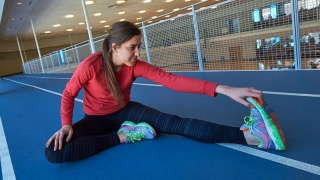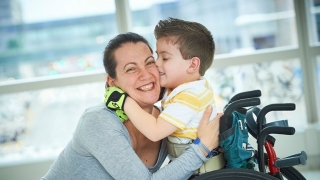Genetic Cervical Spine Conditions
What are genetic cervical spine conditions?
Genes play an important role in a child's overall health. Many cervical spine conditions — both common and rare — have a genetic component. Genetic conditions can be caused by inheritance (passed from parent to child), disrupted or abnormal development in utero, or unknown factors.
Genetic conditions that affect the cervical spine vary widely. Each condition has its own set of symptoms, treatment options and long-term outcomes. Some are visible at birth, while others are not as obvious and are only diagnosed as signs and symptoms develop.
Each genetic disease or syndrome can vary in severity from child to child and affect one child differently throughout the course of his growth and development. Many of the genetic conditions don't just affect the cervical spine, but also create multiple medical issues that can affect a child's outward appearance, internal organs and overall function.
Because of the complex nature of these genetic conditions, an experienced multidisciplinary team is needed to assess each child's individual condition and develop a customized care plan.
The conditions we treat include:
Mid-cervical
- Diastrophic dysplasia
- Larsen syndrome
Upper-cervical
- 22q11.2 deletion syndrome
- Down syndrome (trisomy 21)
- Fibrodysplasia ossificans progressive (FOP)
- Goldenhar syndrome
- Klippel-Feil syndrome
- Kniest dysplasia
- Morquio syndrome (mucopolysaccharidosis type IV)
- Pseudoachondroplasia
- Spondyloepiphyseal dysplasia congenital (SED)
Other syndromes known to have cervical spine associated problems
- Aarskog syndrome
- Apert syndrome
- Atelosteogenesis, type 1
- Campomelic dysplasia
- Cervico-Ocuolo-Acoustic syndrome (Wildervanck syndrome)
- Chondrodysplasia punctata
- Cleidocranial dysostosis
- Dyggve-Melchior-Clausen syndrome
- Ehlers-Danlos syndrome IV
- Fetal alcohol syndrome
- Frontometaphyseal dysplasia
- Hajdu-Cheney syndrome
- Hurler syndrome
- Marfan syndrome
- Maroteaux-Lamy syndrome (mucopolysaccharidosis type VI)
- Marshall-Smith syndrome
- Melorheostosis
- Metaphyseal chondrodysplasia
- Metatropic dysplasia
- Mucopolysaccharidoses (MPS)
- Multiple epiphyseal dysplasia
- Osteopathia striata
- Osteopoikilosis
- Pyknodysostosis
- Spina bifida
- Spondylocarpotarsal synostosis syndrome
- Spondyloepimetaphyseal dysplasia
- Spondylometaphyseal dysplasia-Kozlowski (Kozlowski spondylometaphyseal dysplasia)
- Weaver syndrome
Signs and symptoms
Specific symptoms depend on the particular condition, but symptoms may include:
- Spinal deformities like scoliosis, kyphosis or lordosis
- Cervical spine instability
- Hip and joint deformities
- Bone fractures
- Facial deformities, such as cleft palate, jaw malformations and dental problems
- Short neck with restricted mobility and pain
- Organ abnormalities including kidney, lungs, heart, liver, GI tract
- Chest deformity
- Misshapen, fused or absent ribs
- Breathing difficulties
- Short stature (dwarfism)
- Abnormal growth of arms and legs
- Hand and foot anomalies
- Vision and hearing impairments
- Skin abnormalities
- Delayed or accelerated development and growth
- Intellectual and/or cognitive disabilities
Testing and diagnosis
Some conditions may be diagnosed prenatally with ultrasound while the unborn child is still in the womb. Many other conditions are only determined after birth — some not until adolescence.
At Children’s Hospital of Philadelphia (CHOP), diagnostic evaluation for genetic conditions that can affect the cervical spine generally begin with a thorough medical history and physical examination of your child by a physician.
Our clinical experts use a variety of diagnostic tests to diagnose genetic conditions that can affect the cervical spine, including:
- X-rays, which produce images of bones.
- Magnetic resonance imaging (MRI), which uses a combination of large magnets, radiofrequencies and a computer to produce detailed images of organs and structures within the body.
- Computed tomography (CT) scan, which uses a combination of X-rays and computer technology to produce cross-sectional images ("slices") of the body.
- Radioisotope bone scan, which can help locate areas of abnormal growth.
- Blood and urine tests, which can help determine drug usage and effectiveness, biochemical diseases and organ function.
- EOS imaging, an imaging technology that creates 3-dimensional models from two planar images. Unlike a CT scan, EOS images are taken while the child is in an upright or standing position, enabling improved diagnosis due to weight-bearing positioning.
- Genetic testing, in which a sample of your child’s saliva is used to identify your child’s DNA.
- Arthrography, which uses colored dye injected into a joint — most commonly the shoulder, hip, knee, elbow or wrist — and X-ray images are taken to identify any problems.
- Biopsy, which is a surgical procedure to take a sample of the growth, may be necessary to confirm any findings.
- Ultrasound, which uses ultrasonic waves to image internal body structures and muscles. An ultrasound does not expose your child to radiation.
- Pulmonary function tests or lung scans, to determine how well your child’s lungs work.
- Psychometric exam, to determine if there are any deficits in intelligence.
- Echocardiogram, which examines the heart’s valves and the vessels that carry blood from the heart to the rest of the body.
- EKG, which tests your child’s heart rate and rhythm.
- Biochemical testing, which measures the amount or activity of a particular enzyme or protein in a sample of blood, urine or other tissue from the body.
- Vision and hearing tests.
Treatments
Treatment for genetic cervical spine conditions is multi-pronged because each condition affects several body systems. In some cases, careful monitoring may be all that is required. In other cases, non-surgical or surgical treatments may be needed to address specific aspects of the condition.
At Children’s Hospital of Philadelphia, we practice collaborative, family-centered care. A team of expert clinicians — including world-renowned orthopaedic surgeons and physicians, pediatric nurses, physical and occupational therapists, psychologists and other specialists — will partner with you in the care of your child.
Many children with genetic conditions are also diagnosed with a variety of orthopaedic conditions including: scoliosis, hip dysplasia, hand and foot anomalies, and facial abnormalities.
In some cases, these conditions are present at birth and can — or must — be treated when the child is young. This is the case for many hand and foot anomalies, facial deformities and damage to organs such as the heart, lungs, liver or kidneys.
Orthopaedic experts work closely with specialists from divisions and programs across the Hospital, including:
- Cardiac Center
- Biesecker Liver Disease Center
- Spine Program
- Hip Disorders Program
- Hand and Arm Disorders Program
- Leg and Foot Disorders Program
- Pulmonology
- Gastroenterology, Hepatology and Nutrition
- Neonatal Craniofacial Program and Craniofacial Program
Your child's treatment may include non-surgical options such as bracing and physical therapy, or surgical options such as spinal fusion, implanting growing rods or vertical expandable prosthetic titanium ribs (VEPTR) to stabilize your child’s spine as she continues to grow.
Though spine surgery for genetic conditions is highly effective, we understand that any surgery can be a stressful experience for children and families. At CHOP, we offer a wealth of resources about how to prepare your child for surgery and what to expect during surgery.
Additionally, we employ numerous best practices before, during and after surgery to decrease the risk of infection and increase positive outcomes.
Follow-up care
Because of the complexity of genetic cervical spine conditions, regular follow-up and monitoring will be required.
If your child had spine surgery, he should be seen by an orthopaedic physician one to two weeks post-op, then again at three months and six months post-op. After your child has healed, annual visits with an orthopaedic physician are encouraged.
Our team meets regularly to review your child's progress and revise treatment goals to achieve the best possible outcome. Recognizing that your primary care team also is an important part of the process, we provide regular updates to them on the progress of your child.
During follow-up visits, X-rays and other diagnostic testing may be completed to closely monitor your child’s condition and ensure there are no side effects from surgery.
Follow-up care and ongoing support and services are available at our Main Campus and throughout our CHOP Care Network. Our team is committed to partnering with parents and referring physicians to provide the most current, comprehensive and specialized care possible for your child.
Outlook
Outcomes for children with genetic conditions that affect the cervical spine are varied. The nature of their genetic condition and any other health issues, how quickly the child is diagnosed, and possible treatment options, all factor into a child’s long-term prognosis.
In many of these conditions, early diagnosis and careful monitoring help clinicians determine when is the best time to medically intervene to give your child the best quality and quantity of life.
With ongoing research and advances in treatment options, outcomes for children with genetic cervical spine conditions will continue to improve.

